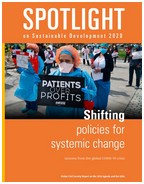SDG Hunger Goal Slumps Further Behind 2030 Target in Key UN Food Report

Scroll Down to Read Analysis: SDG Hunger Goal Slumps Further Behind 2030 Target in Key UN 2023 Food Report
Direct Link to Full 316-Page 2023 Report: https://www.fao.org/3/cc3017en/cc3017en.pdf
SDG hunger goal slumps further behind 2030 target in key UN food report | Devex
SDG Hunger Goal Slumps Further Behind 2030 Target in Key UN Food Report
By Teresa Welsh // 12 July 2023
The world is far behind in achieving the United Nations’ ambitious goal of zero hunger by 2030.
Although the number of hungry people has stabilized from highs during the COVID-19 pandemic, the world is being pushed further away from meeting the United Nations near hopeless goal to eliminate hunger by 2030.
783 million people were hungry, 122 million more than in 2019 before the pandemic. Globally 2.4 billion people, or 29.6% of the population, did not have regular access to food. Of those, an estimated 900 million faced severe food insecurity.
The 2023 State of Food Security and Nutrition in the World report, released on Wednesday, is produced annually by the Food and Agriculture Organization, the International Fund for Agricultural Development, UNICEF, the World Health Organization, and the World Food Programme.
“One of the major messages of the report is that if we run the contrafactual — what would have happened if there was no COVID-19 — we would have seen a decline [in hungry people],” FAO Chief Economist Máximo Torero told Devex, noting there would have also been a decline if the war in Ukraine had not happened.
“We are very far from where we should be for achieving SDG2,” he said, referencing Sustainable Development Goal 2 — eliminating hunger — set in 2015 by the U.N General Assembly.
Although the target is impossible anyway, it is growing further out of reach: Projections show approximately 600 million people will be undernourished in 2030. While there has been progress in increasing exclusive breastfeeding — no solids or formula — for the first six months of life and reducing stunting for children under 5 years, those 2030 targets remain unachievable at current rates.
The prevalence of wasting, or children with a low weight for their height, is more than double the 2030 target.
While hunger numbers improved in most parts of Asia and in Latin America, there was a rise in Western Asia, the Caribbean, and Africa in 2022. The continent has the highest number of hungry people of any region, at 20%, while 8.5% of Asia, 6.5% of Latin America and the Caribbean, and 7% of Oceania are hungry.
The hunger numbers after COVID-19 show the power of social protection systems, Torero said. Latin America, which had robust systems in place to help people whose food security was threatened by the pandemic, did not see such a drastic uptick in those who were hungry. But Africa was hugely affected because many governments could not help their populations weather the shock in the same way.
“Africa didn’t have the capacity of absorption, didn’t have that capacity of social protection programs which were very well targeted. And therefore, they have to pay the consequences of that,” Torero said.
African food security has also been affected by the rise in fertilizer prices caused by the war in Ukraine. Other regions were able to pay higher prices, while farmers in Africa could not afford the fertilizer they needed, Torero said. Debt distress has also severely hindered African countries, where governments have less money available to help their populations due to high-interest rates and exchange rate devolution.
An estimated 3.1 billion people — 42% of the world’s population — didn’t have access to healthy diets in 2021, according to the report. Data for the report’s healthy diet metric, which lags by one year, found 52 million more people could afford a decent daily intake in 2021 over 2020. Torero said the public sector, private sector, international financial institutions, and foundations all have a role to play in helping improve access to nutritious food.
“The public sector already supports agriculture, and there’s where we need to find and understand where changes have to happen so these public expenditures are aligned towards creating incentives to produce healthy diets,” Torero said. “I honestly think that if we look carefully at the financing mechanisms … and look at the challenges that we have to solve, we can really target interventions that could have a big payoff.”
The World Bank and the G7 have a new dashboard tracking the food crisis and will which enable predictive modeling to fill in the gaps, as some of the countries facing the worst problems have the least data. The tool also keeps tabs on funding.
The report focused on urban food systems, as it is estimated that nearly 70% of the world’s population is expected to live in a city by 2050. The trend could endanger nutrition security because instead of growing their own food, people have easier access to cheap, packaged, processed foods. But urban food systems also provide greater opportunities to increase incomes and give farmers better access to inputs and services as rural areas become more connected to cities.
The overall troubling numbers shouldn’t be cause to give up on trying to eliminate hunger, Torero said.
“Although the news [is] not good because the numbers are very high, I still think that the fact that it has stabilized in spite of the additional shock of the war tells us that now we have a window to turn this [around],” Torero said.
Извор: WUNRN – 15.07.2023



